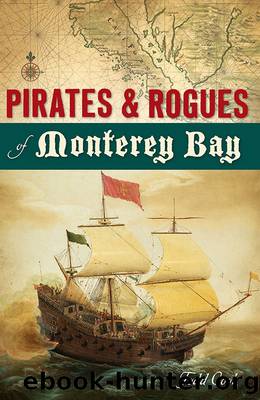Pirates Rogues of Monterey Bay by Todd Cook

Author:Todd Cook [Cook, Todd]
Language: eng
Format: epub
Tags: History, United States, State & Local, General
ISBN: 9781467143639
Google: -_-4DwAAQBAJ
Publisher: Arcadia Publishing
Published: 2019-01-15T03:26:17+00:00
THE OAK
Remember our Celtic-styled stone marker on the grass plot at the corner of Pacific Street and Artillery Boulevard in Monterey? Thatâs the spot where one needs to stand and ponder pirate-related VizcaÃno history, because that is where âThe Oakâ once stood, more or less. I say that because, if you stand in front of that stone cross today, you have to imagine the ground dropping out from under you, revealing a fifteen-foot drop to the bottom of a ravine belowâthe waters of the bay actually would have been washing up into the entrance of the ravine below in 1602. Below the crossâabout six or seven feet below todayâs ground levelâis where the base of the oak tree would have been, clinging to the grassy slope adjacent to the ravine. To put it another way, the site, as it appears now, is quite different than how it appeared in 1602. Back then, where the stone cross now stands there would have been a steep hillside dropping down to the bay waters. Today, the stone cross stands on a level grass plot, several yards away from the waterfront. This is because of significant landfill for railroad tracks and concrete roadways that started in the late 1800s. The ravine itself still existsâyou can see it just a few paces behind the stone crossâbut the ravine has filled in quite a bit since the 1600s and 1700s. It no longer empties into the bay (or it doesâjust a trickleâs worthâbecause it now has to pass through a long culvert).
As for âThe Oak,â it was otherwise known as the VizcaÃno-Serra Oak because both VizcaÃno and Father Serra held mass beneath the branches of that oak in 1602 and 1770, respectively, and it stood where the stone monument now stands. Donât look for any image or inscription about VizcaÃno on the stone monumentâthere is none. The monument, erected in the early 1900s, does depict, however, a Celtic-styled cross, an image of Father Serra and a rendering of the Carmel Mission. Youâre probably thinking: But what happened to the historic oak tree? Well, it continued to stand over Monterey Bay until 1905, when it died. That year, utility workmen accidentally chopped down the venerated oak and tossed it in the bay. Fortunately, the main trunk was found bobbing in the bay and was fished out at the insistence of an aghast local priest. Today, trunk remnants of the historic tree can still be viewed at the Royal Presidio Chapel Heritage Center in Monterey and also at the Carmel Mission. A crude chair fashioned from remnants of the oak is also on display at the Pacific Grove Museum of Natural History.
I think the following bit of little-known Oak-related history is well worth mentioning. Bear in mind that the actual VizcaÃno landing date at Monterey Bay was December 17, 1602. VizcaÃno and his crew lingered at Monterey Bay to rest and explore for another two weeksâin fact, they were the first Europeans to view the Carmel Valley. They did not sail away until January 3, 1603.
Download
This site does not store any files on its server. We only index and link to content provided by other sites. Please contact the content providers to delete copyright contents if any and email us, we'll remove relevant links or contents immediately.
| Africa | Americas |
| Arctic & Antarctica | Asia |
| Australia & Oceania | Europe |
| Middle East | Russia |
| United States | World |
| Ancient Civilizations | Military |
| Historical Study & Educational Resources |
The Boundless Sea by David Abulafia(717)
Navigation by Jim Bennett(587)
The Last Voyage of the Andrea Doria by Greg King(457)
Three Sheets to the Wind by Cynthia Barrett(417)
Guide to the Crew of Titanic by Babler Gunter(305)
The Titanic Disaster by James W Bancroft(191)
A World of Empires: The Russian Voyage of the Frigate Pallada by Edyta M. Bojanowska(185)
Pirates: A New History, From Vikings to Somali Raiders by Peter Lehr(183)
Under Sail by Felix Riesenberg(166)
Why the Titanic was Doomed by Bryan Jackson(153)
Pirates Rogues of Monterey Bay by Todd Cook(129)
Poxed & Scurvied: The Story of Sickness and Health at Sea by Kevin Brown(127)
The Combined Operation by Youds Peter(120)
He Became a Salted Fish After Inheriting Millions of Secret Arts by Lips Are Lost 0(119)
SHIPWRECK by DAVE HORNER(115)
Sea Stories by Tom McCarthy(114)
The History of Navigation by Dag Pike(108)
The Wreck of the Neva by Cal McCarthy(102)
Pirates_A New History, From Vikings to Somali Raiders by Peter Lehr(88)
